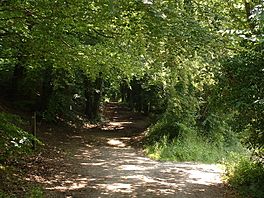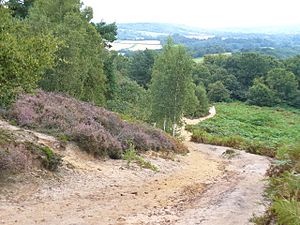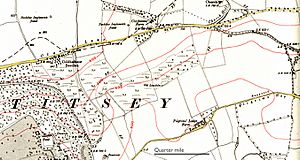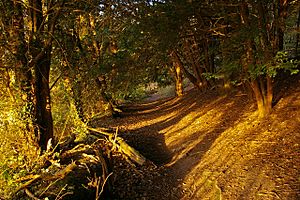Pilgrims' Way facts for kids
Quick facts for kids Pilgrims' Way |
|
|---|---|

Pilgrims' Way near Westwell, Kent
|
|
| Length | 192 km (119 mi) |
| Location | South Eastern England, United Kingdom |
| Trailheads | Winchester, Hampshire Shrine of Thomas Becket, Canterbury, Kent |
| Use | Hiking, cycling and byway; former pilgrim way |
| Season | All year |
The Pilgrims' Way is a very old path in England. It's known as the route that pilgrims supposedly took from Winchester in Hampshire to the special church of Thomas Becket in Canterbury, Kent.
Even though it's called the Pilgrims' Way, this path is much older than the pilgrim journeys! It's an ancient trackway that archaeologists believe was used as far back as 600 to 450 BC. Some think it might even have been around since the Stone Age. This old route followed the natural hills of the North Downs, avoiding muddy areas and sticking to higher ground.
Contents
The Story of the Pilgrims' Way
An Ancient Path
This ancient path was used for over 3,000 years! It stretched further than the modern Pilgrims' Way. It connected the narrowest part of the English Channel to important old religious sites like Avebury and Stonehenge. Even during Roman times, people used this path for travel.
Why Pilgrims Walked This Way
After Thomas Becket became a saint in 1173, his shrine in Canterbury became one of the most important places to visit in the country. It was even called "the chief shrine in Christendom" after Rome. Pilgrims came from all over to visit it.
Winchester was a big starting point for many travelers. It was also an important religious center itself. Many people believe that King Henry II used this route in 1174 when he traveled from France to Canterbury. He was going there to make up for Thomas Becket's death.
People traveling from Winchester to Canterbury naturally used this old path because it was a direct route. While we don't know exactly how many pilgrims used this specific path, it was certainly a popular way to travel. Another famous route to Canterbury from London was by Watling Street. This is the path followed by the storytellers in The Canterbury Tales by Geoffrey Chaucer.
How the Name "Pilgrims' Way" Started
The idea of a single route called the Pilgrims' Way might not be as old as you think. It became very popular after a mapmaker from the Ordnance Survey published a pamphlet about it in 1871. He suggested the name, and it was then put on official maps.
Writers like Hilaire Belloc helped make the name famous. However, some historians say that the name "Pilgrims' Way" was used in old records even before 1815. For example, documents from the 1200s mention a "Pilgrim Road" near Thurnham Castle in Kent.
The Pilgrims' Way is also a central part of the 1944 film A Canterbury Tale. The movie even starts with a camera showing a map of the route.
Following the Path

If you were a pilgrim walking from Winchester, you would have started on a Roman road. This path goes through towns like New Alresford, Alton, and Bentley to Farnham. This part of the route is similar to the modern A31.
From Farnham, the old main streets of towns like Guildford, Dorking, and Reigate line up from west to east. This shows that this was a very important route through these towns. On modern maps, parts of the route go east from Farnham, past Guildford Castle, and then north of villages like Shere, Dorking, Reigate, Merstham, and Godstone. It continues through Otford, Kemsing, and Wrotham, heading towards Cuxton. Here, it crossed the River Medway.
South of Rochester, the Pilgrims' Way goes through villages such as Burham, Boxley, and Detling. It then continues southeast, staying on top of the Downs, past Charing to Wye. Finally, it turns north to follow the valley of the Great Stour through Chilham and on to Canterbury.
Sometimes, the pilgrims' route left the very old trackway to visit important religious places. For example, near Guildford, the later path went past St Martha's Hill and St Catherine's chapel. In Reigate, a chapel and a hospice were built for pilgrims, even if they weren't directly on the main path. Boxley Abbey, with its special Rood of Grace, was another place pilgrims would detour to see.
Modern Walking Trails
The North Downs Way National Trail is a modern walking path that follows the old Pilgrims' Way between Farnham and Canterbury. Much of the original Pilgrims' Way is now part of modern roads. So, walking groups like The Ramblers suggest that people who want to follow the historic route use the St. Swithun's Way from Winchester to Farnham, and then the North Downs Way from Farnham to Canterbury.
The Pilgrims' Way also connects with the South Downs Way at Winchester.




